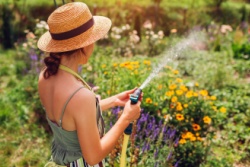
With spring now in full swing, you might have noticed that the days are much longer and the sunlight is making more of an appearance.
With this often comes the return of nature as birds’ morning chorus is much noisier and butterflies start appearing in your garden.
Bioregional reveals that the UK is home to an estimated 24 million gardens, and they’re becoming increasingly important for the conservation of native wildlife.
In fact, domestic gardens can actually lead to significant habitat loss. The use of pesticides and intensively managed lawns further reduces biodiversity, and even pets – especially cats – can pose a threat to small mammals and birds.
Research reported by the National History Museum suggests that 1 in 6 species of UK wildlife is at risk of extinction, so it’s as important as ever to ensure that your garden is a sanctuary for local animals.
Thankfully, you can do so with just a few small adjustments. Continue reading to discover how you can alter your garden to benefit the local ecosystem.
Consider introducing more biodiversity to your garden
A diverse garden filled with different plants and habitats tends to be far more inviting to wildlife than a neatly trimmed lawn.
If you incorporate a variety of plants at different heights and structures, you provide shelter and nourishment for numerous species.
For instance, taller bushes and even small trees can offer the ideal nesting spots for birds and act as a refuge for smaller mammals. Lower-growing shrubs and flowering plants, meanwhile, can provide essential cover for insects and pollinators, such as bees and butterflies.
Another way to encourage biodiversity in your garden is by “rewilding”. This concept is gaining support in the UK, with Rewilding Britain reporting that four in five Brits are in favour of the idea.
Rewilding essentially involves letting parts of your garden grow untamed, avoiding pesticides and creating mini ecosystems that foster wildlife.
If possible, you may even want to introduce a water feature, such as a small pond. This could attract amphibians such as frogs, provide drinking water for birds and mammals, and even serve as a breeding ground for insects – which, in turn, act as a source of food for birds.
Make sure to choose the right plants
The plants you choose play a significant role in supporting wildlife visiting your garden. Some UK-native wildflowers can provide essential food for pollinators, while adding a burst of colour to your garden. These could include:
- Ox-eye daisies
- Cornflowers
- Knapweed
- Poppies
- Foxglove
- Marigolds
Butterflies, in particular, benefit from plants such as buddleia – often called the “butterfly bush” – which attract them in abundance. Just note that buddleia is considered invasive and may damage brickwork, so it might be prudent to plant them away from your home.
If you’re looking for an easy way to introduce wildflowers, you may want to make use of “bee bombs”.
These small seed pods contain a mix of wildflower seeds which you scatter around your garden, and they’ll eventually bloom into patches of flowers. Better yet, they’re often encased in peat or clay, protecting the seeds from birds.
While encouraging plant growth, you may also need to deter pests such as slugs and snails. Instead of using harmful pesticides, you could consider wildlife-friendly control methods.
For example, companion planting – where certain plants naturally repel pests – or physical barriers such as eggshells can keep slugs away while protecting the ecosystem of your garden.
Provide food for wildlife
Another simple yet effective way to encourage wildlife into your garden is by offering them a reliable food supply.
A bird feeder can attract a wide variety of birds, and different types of feed will appeal to different species. Mealworms, for example, are a favourite of robins and blue tits, while sunflower seeds tend to attract goldfinches.
If you want to spot a hedgehog roaming around your garden, you could leave out a dish of grubs or meat-based cat food for them. Just be sure to avoid milk and bread, as these can be harmful to their digestive systems.
Insects also need shelter and sustenance, so you could create an “insect hotel” by stacking logs, twigs, and other natural materials to provide a home for insects, such as ladybirds and bees.
Not only can this support biodiversity, but it also offers a valuable food source for birds and small mammals that visit your garden.
Create wildlife “corridors”
Just as you might need clear pathways to navigate your garden, so too does wildlife. Many animals, especially hedgehogs and amphibians, rely on these safe routes to move between gardens and green spaces, and without them, their movement is restricted.
As such, you could create small gaps at the bottom of fences. Even a simple hole – perhaps around 13cm – could allow hedgehogs to pass through safely.
If a solid wall prevents this, climbing plants, such as ivy or honeysuckle, can create vertical pathways for creatures.
Similarly, hedges can act as essential “highways” for wildlife. Unlike solid fences, hedges provide shelter, nesting sites, and even a natural route for small animals and birds to travel safely away from predators.
If you are considering planting a new hedge, a species such as hawthorn or blackthorn could be wise, as they provide additional food sources through their berries.
Get in touch
Just as you might be searching for ways to make your garden spring-ready, we could future-proof your finances for the entire year.
To find out how we can help, please contact us by email at info@investmentsense.co.uk or call 0115 933 8433.
Please note
This article is for general information only and does not constitute advice. The information is aimed at retail clients only.
All information is correct at the time of writing and is subject to change in the future.


